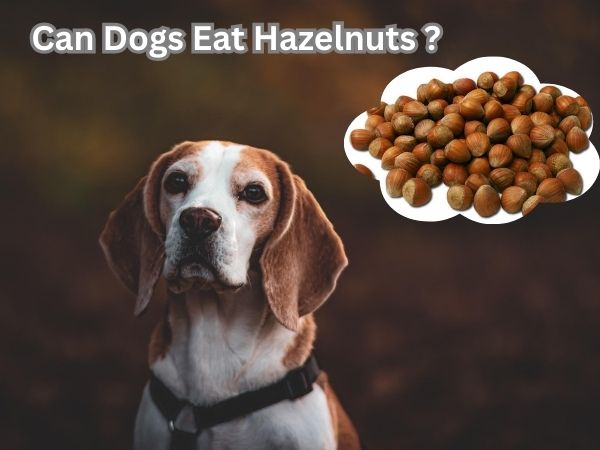Can Dogs Eat Hazelnuts? 9 Hidden Dangers Revealed

Hazelnuts are nutritious for people. They contain vitamin E, healthy fats, protein, and antioxidants that support heart health and digestion. But are they safe for dogs?Can dogs eat hazelnuts? Can dogs get the same benefits from hazelnuts?
Before you give your dog any hazelnuts, it’s important to know the facts. There are some risks that every pet owner should be aware of.
Human foods and snacks are linked to about a quarter of reported pet poisonings. Understanding the facts can help you keep your dog safe and healthy.
What Are Hazelnuts?
Hazelnuts are small, round nuts that come from hazel trees. You’ll find them in lots of kitchens, baked goods, and mixed nuts. They’re full of healthy nutrients for people, like omega-3s, vitamin E, and magnesium. But just because hazelnuts are good for us doesn’t mean they’re safe for dogs.
Can Dogs Eat Hazelnuts?
Hazelnuts aren’t toxic to dogs, but that doesn’t mean they’re a good treat. It’s important for dog owners to know that not being poisonous doesn’t always mean something is safe. For example, a plastic toy isn’t toxic, but you still wouldn’t want your dog to eat it.
The Non-Toxic vs. Dangerous Distinction
Hazelnuts won’t poison your dog the way chocolate or grapes can, but they still come with serious risks. Dogs can choke on them, get digestive blockages, or even develop pancreatitis because hazelnuts are high in fat.
The 9 Hidden Dangers of Hazelnuts for Dogs
Hazelnuts might look like a harmless treat to share with your dog, but they can actually be risky. They aren’t poisonous, but they can still cause some real health issues for your pup.
Danger #1: Choking Hazards
Because hazelnuts are round and hard, they can be a real choking hazard for dogs. This can quickly turn into an emergency if your dog can’t breathe.
Size and Shape Risks
Hazelnuts are small and round, which makes them easy for a dog to accidentally swallow whole. If one gets stuck in your dog’s throat, it can block their airway and become very serious, very fast. Since hazelnuts are also hard, they don’t break apart easily, so they can get stuck further down in the digestive system too.
Small vs. Large Dog Considerations
Small dogs are especially at risk. Their throats are tiny, so even one hazelnut can block their airway and stop them from breathing.
Big dogs can have problems too. Some large breeds eat so fast that they don’t chew their food, so they might swallow hazelnuts whole and choke as well.
Emergency Response Steps
If your dog is choking on a hazelnut, you need to act fast. Here’s what you should do right away:
- Check the mouth – Open the dog’s mouth carefully and look for visible obstructions that can be safely removed with fingers or tweezers
- For small dogs – Hold them on your lap, turn them onto their back, and apply firm pressure with your palm just below the rib cage
- For large dogs – Lift their hind legs while keeping their front paws on the ground, then apply firm upward pressure below the rib cage
- Contact emergency veterinary care immediately, even if you successfully dislodge the object
- Monitor breathing – Watch for signs of continued distress, difficulty breathing, or blue gums, which require immediate professional intervention
Never attempt to push objects further down the throat, as this can worsen the blockage. If the dog loses consciousness, perform rescue breathing while heading to the nearest emergency veterinary clinic.
Danger #2: Intestinal Blockage
If your dog eats hazelnuts, there is a real risk of an intestinal blockage that could threaten their health.
Shell Thickness Issues
Hazelnut shells are very tough, and dogs often swallow them whole. Your dog’s stomach can’t break down these shells, so they can get stuck and cause problems inside your dog’s body.
Digestive Tract Complications
If a dog eats hazelnuts, the shells can get stuck anywhere in their digestive system. This is especially dangerous for small dogs and puppies because their intestines are smaller.
Watch for these warning signs of intestinal obstruction in your dog:
- Repeated vomiting that won’t stop
- Difficulty passing bowel movements or straining
- Diarrhea or severe constipation
- Loss of appetite and refusal of food
- Lethargy and weakness
- Bloating and abdominal pain
- Hunching over or whining from discomfort
If you notice these signs, take your dog to the vet right away. Blockages can become very serious fast.
Danger #3: Pancreatitis Risk
Hazelnuts are tasty, but their high fat content can be hard on a dog’s pancreas and may cause pancreatitis, which is inflammation of the pancreas. Even a small amount of fatty nuts or table scraps can trigger this, especially in dogs that are already at risk.
High Fat Content Dangers
If a dog eats too much fat at once, the pancreas releases extra digestive enzymes, which can cause inflammation. This may lead to stomach pain, vomiting, and dehydration that requires quick veterinary attention. Giving nuts as treats regularly can also increase a dog’s weight and blood fat levels, putting extra stress on the pancreas.
If your pup sneaks hazelnuts, watch closely for these common pancreatitis warning signs:
- Repeated vomiting or retching, sometimes with foam or bile
- Watery diarrhea or unusually greasy stools
- Tight, painful belly; many dogs hunch or take a “praying” pose to ease the ache.
- Sudden loss of interest in food or treats they normally love
- Extreme tiredness, weakness, or a feverish feel to the ears and paws
- Signs of dehydration, such as dry gums or sunken eyes
If you notice any of these signs, contact your veterinarian as soon as possible. Fast treatment with fluids and anti-nausea medication can help prevent serious complications.
Long-Term Health Effects
Pancreatitis can happen more than once. If it keeps coming back, it can damage the pancreas and may lead to diabetes or other long-term health problems that require special diets and medication. Ongoing inflammation can also cause low energy, weight loss, and a dull coat.
Simple Prevention Tips
- Skip hazelnuts, table scraps, and fatty meats; choose low-fat training treats instead.
- Keep garbage lids tight and holiday snack bowls out of paw’s reach.
- Feed smaller, more frequent meals to ease digestive strain and keep that playful tail wagging.
By being careful now, you can help protect your dog’s pancreas and keep them healthy and happy in the long run.
Danger #4: Mold Contamination (Aflatoxins)
If hazelnuts get moldy, they can be really dangerous for your dog. The mold makes toxins called aflatoxins, and these are some of the worst things your dog could eat.
Mycotoxin Dangers
Aflatoxins are toxins made by mold that often grows on nuts, especially if hazelnuts are kept somewhere warm and damp. Dogs are extra sensitive to these toxins because their bodies can’t get rid of them very well. Even a little bit of moldy hazelnut can make your dog really sick.
Watch for these warning signs of mycotoxin poisoning in your dog:
- Vomiting and loss of appetite
- Diarrhea and digestive upset
- Lethargy and weakness
- Tremors or seizures
- Jaundice (yellowing of eyes and gums)
- Difficulty breathing or panting
Liver Damage Potential
The biggest worry with aflatoxin poisoning is how badly it can hurt your dog’s liver. These toxins go straight for the liver and can cause swelling or even lasting damage. It doesn’t take much—just a small amount can be deadly in a few days. Liver problems from aflatoxins can also make your dog bruise or bleed more easily than normal.
Storage-Related Risks
Hazelnuts can easily get moldy, especially when they’re being picked, dried, or stored. If they’re kept somewhere warm and damp, mold can grow fast. Sometimes you won’t even see any mold, but the toxins can still be there and just as dangerous for your dog.
The risk increases significantly with:
- Old or stale hazelnuts
- Nuts stored in humid environments
- Damaged shells that allow mold entry
- Poor storage conditions during transport
If you think your dog might have eaten moldy hazelnuts or is showing any of these signs, call your vet right away. Acting fast can make all the difference with aflatoxin poisoning.
Danger #5: Allergic Reactions
Just like people, dogs can have food allergies, and nuts are one of the usual triggers. Hazelnuts can sometimes cause allergic reactions in dogs, similar to other tree nuts.
Common Symptoms
If your dog eats hazelnuts, keep an eye out for these signs of an allergic reaction:
- Persistent itching and scratching are the most common signs of food allergies in dogs.
- Facial or body swelling, particularly around the eyes, mouth, or throat
- Digestive distress, including vomiting or diarrhea
- Difficulty breathing or excessive panting
- Red, inflamed skin or hives that appear as raised, itchy patches
Breed Predispositions
Some breeds are more likely to have allergies because of their genetics. Dogs that are more prone to allergies include:
- Golden Retrievers and Labrador Retrievers – These breeds are genetically prone to developing various allergies throughout their lifetime.
- German Shepherds – Particularly susceptible to food-related allergies, especially proteins
- Boxers, Boston Terriers, and Bulldogs – These breeds have an increased likelihood of allergic reactions
- Poodles, Pugs, and Cocker Spaniels – These breeds also show higher rates of allergy development.
Danger #6: Gastrointestinal Upset
Dogs have a hard time digesting hazelnuts because their stomachs are not made for nuts. The fat in hazelnuts can upset your dog’s stomach and make them feel sick. Eating hazelnuts can cause stomach problems for your dog.
Vomiting and Diarrhea
If your dog eats hazelnuts, look for these signs of stomach upset, which usually show up within a few hours:
- Vomiting – This is often the first sign of digestive distress and can range from mild to severe
- Diarrhea – Loose, watery stools that may persist for several hours or days
- Abdominal pain – Your dog may show signs of discomfort, restlessness, or reluctance to move
- Loss of appetite – Dogs experiencing gastrointestinal upset often refuse to eat or accept treats.
- Lethargy – Your normally active pup may seem tired or less energetic than usual
These problems happen because hazelnuts are hard for dogs to digest. The fat in them can upset your dog’s stomach and lead to vomiting or diarrhea, which can be tough for both you and your dog.
Danger #7: Weight Gain and Obesity
Hazelnuts pose a significant risk to your dog’s waistline due to their extremely high caloric content. Dogs can develop serious weight issues when they consume excessive amounts of nuts, and hazelnuts are particularly problematic due to their high-calorie content. Just like people, dogs who gain extra weight face numerous health challenges that can affect their quality of life.
Caloric Density Issues
The main issue with hazelnuts is how many calories they contain in a small amount. Just a small serving can have 150 to 200 calories, which is more than most dogs should have in a treat. Even a few hazelnuts can put your dog over their daily calorie limit. If your dog is overweight or gains weight easily, it is best to avoid hazelnuts altogether.
Long-Term Health Impacts
When dogs consume hazelnuts regularly, the excess weight can lead to serious long-term health problems. The extra pounds affect their energy levels and contribute to issues like:
- Diabetes and metabolic disorders
- Joint pain and decreased mobility
- Heart disease and breathing difficulties
- Shortened lifespan and lower quality of life
Hazelnuts are also high in fat, which can make dogs more likely to get pancreatitis. This is a painful condition that needs quick treatment from a vet.
Portion Size Concerns
Even small amounts of hazelnuts can be too much, since treats should be less than 10% of your dog’s daily calories. Because hazelnuts are small, it is easy to give too many by accident. Try giving your dog low-calorie snacks like carrot sticks or apple slices instead. These are crunchy and safer for their weight.
Danger #8: Flavored Hazelnut Dangers
Flavored hazelnuts are even more dangerous for dogs than plain ones. They often have extra ingredients that can cause serious health problems.
Chocolate Coating Risks
Chocolate-coated hazelnuts are extremely dangerous for dogs. Chocolate contains theobromine and caffeine, two toxic compounds that dogs cannot properly metabolize. These substances affect the central nervous system, heart, and kidneys, causing rapid breathing, increased heart rate, vomiting, diarrhea, and potentially seizures. Dark chocolate coating poses the highest risk, as it contains more concentrated levels of these toxic compounds.
Xylitol Toxicity
Many flavored hazelnuts contain xylitol, an artificial sweetener that is extremely toxic to dogs. Xylitol causes a rapid insulin release in dogs, leading to severe hypoglycemia (low blood sugar) within 30 minutes to an hour. This can progress to liver failure within 8-12 hours.
Symptoms of xylitol poisoning include:
- Vomiting and diarrhea
- Weakness and lethargy
- Loss of coordination
- Seizures and potential coma
Even small amounts can be deadly – just one piece of xylitol-containing gum can poison a 10-pound dog.
Salt and Sugar Content
Flavored hazelnuts typically contain high levels of salt and sugar, which are harmful to dogs. Flavored hazelnuts usually have a lot of salt and sugar, which are not safe for dogs. Too much salt can cause sodium poisoning, and too much sugar can lead to weight gain, dental issues, and even pancreatitis.nd long-term health complications in dogs.
Danger #9: Mixed Nut Complications
Mixed nuts are risky for dogs because some types are toxic. Macadamia nuts, walnuts, pecans, pistachios, cashews, and hickory nuts are especially dangerous. Even a small amount can cause vomiting, diarrhea, seizures, or other serious health issues.
When nuts are mixed, it is hard to know which ones your dog might eat. The safest choice is to avoid giving your dog any nuts from mixed containers.
Cross-Contamination Risks
Nut mixes often have coatings or additives that are also unsafe for dogs. Chocolate, raisins, salt, sugar, and seasonings like garlic can be just as harmful as the nuts.
Nuts can also grow mold during storage, which makes them dangerous for dogs. Mold can produce toxins that cause nerve problems, liver damage, or seizures. You may not see the mold, but it can still harm your dog.
Trail Mix Dangers
Trail mix is especially risky for dogs, not just because of the nuts. Many trail mixes have raisins, which are very toxic and can cause kidney failure. Other ingredients like chocolate chips, dried fruit, and sweeteners make it even more dangerous.
If dogs consume trail mix, watch for these warning symptoms:
- Vomiting and diarrhea
- Increased thirst and urination
- Excessive panting and restlessness
- Elevated heart rate
Because trail mix has high-fat nuts and toxic ingredients, it is very dangerous for dogs. If your dog eats trail mix, contact your vet right away.
Symptoms of Hazelnut Poisoning in Dogs
Immediate Symptoms
If your dog eats hazelnuts, you might notice symptoms within a few hours. Choking is a major concern, especially for small dogs who can struggle with the size and hardness of the nut. Watch for signs like trouble breathing, heavy panting, or your dog acting upset as they try to clear their throat. Upset stomach is also common, and you may see vomiting or diarrhea early on. Your dog could seem tired, weak, or have a sore belly. Some dogs develop a rapid heartbeat or seem restless after eating hazelnuts.
Delayed Reactions
More serious problems can appear 8 to 12 hours after your dog eats hazelnuts. Pancreatitis is a major risk because hazelnuts are high in fat. Dogs with pancreatitis often have severe belly pain and may lie with their chest down and back end up, almost like they are praying. You might notice yellow diarrhea, repeated vomiting, fever, or signs of dehydration. Your dog may lose their appetite and stay tired for days. If the hazelnuts had mold, your dog could develop tremors, seizures, or trouble walking.
Emergency Warning Signs
Certain symptoms require immediate veterinary intervention. Continuous choking, severe difficulty breathing, or signs of complete airway obstruction demand emergency care. Repeated vomiting that prevents the dog from keeping water down indicates serious complications. Collapse, extreme weakness, or unconsciousness signal life-threatening conditions. Seizures or neurological symptoms suggest possible toxin exposure and require urgent treatment.
What to Do if Your Dog Ate Hazelnuts
Step-by-Step Action Plan
Start by staying calm. Figure out how many hazelnuts your dog ate and whether they had any shells or coatings. Remove any leftover hazelnuts so your dog can’t eat more. Check your dog’s mouth for pieces that could cause choking. Watch their breathing and behavior closely. Write down when your dog ate the hazelnuts and any symptoms you notice, as this information will help your vet. If chocolate was involved, treat it as an emergency and call your vet right away, since chocolate toxicity can be fatal and symptoms may take up to 12 hours to appear.
When to Call the Vet
Contact your veterinarian immediately if your dog shows any signs of choking, difficulty breathing, or severe distress. Dogs that consume large quantities of hazelnuts or chocolate-containing products need prompt medical evaluation. Even if symptoms seem mild initially, it’s wise to call your vet for guidance, especially if your dog has underlying health conditions like obesity, kidney issues, or previous pancreatitis. Seek emergency veterinary care right away if your dog shows signs of:
- Severe difficulty breathing or gasping for air
- Significant facial or throat swelling
- Collapse or loss of consciousness
- Rapid progression of symptoms
Even mild reactions, such as hives, can progress to life-threatening anaphylaxis with repeated exposure, making immediate veterinary attention crucial for your dog’s safety.
Home Monitoring Guidelines
If your dog ate a small amount of plain hazelnuts without shells, you may be able to monitor them at home, but check with your vet first. Watch their appetite, energy, and bathroom habits. Make sure they have fresh water, but don’t try to feed them if they seem nauseous. Write down any symptoms and when they happen. If your dog gets worse or new symptoms appear, call your vet right away.
If you need to help a choking dog, the Heimlich maneuver depends on their size. For small dogs under 30 pounds, hold them with their back against your chest and find the soft spot below the ribs. Use both hands to push up quickly toward the head. For larger dogs, lay them on their side and press behind the last rib with quick, upward pushes. You can also lift their back legs and push up on their belly.
If your dog is awake and lets you, gently open their mouth and pull the tongue forward to see better. Use your finger to sweep the mouth, but be careful not to push anything deeper. Only try to remove objects you can see and grab easily. If your dog is unconscious or you can’t see the object, go straight to the Heimlich maneuver.
When to Rush to an Emergency Vet
Even if you remove the hazelnut, your dog still needs to see a vet right away. Choking can hurt their throat or cause other injuries you can’t see. If you can’t remove the nut after a few attempts, take your dog to the emergency vet immediately and continue trying to help on the way. If your dog passes out while choking, they need emergency care, even if they wake up. Problems can appear hours later, so a vet check is crucial.
Safe Alternatives to Hazelnuts for Dogs
Instead of giving your dog risky nuts like hazelnuts, try these safe treats that most dogs really enjoy. You can purchase chicken-based training treats, freeze-dried fish, or low-fat treats specifically designed for dogs with sensitive stomachs. Select treats with real meat listed first and avoid those with artificial preservatives or flavors.
Popular vet-approved choices include:
- Hill’s Natural Training Treats with real chicken protein
- Blue Buffalo Health Bars with apples and yogurt
- Vital Essentials freeze-dried minnows for omega-3 benefits
- Full Moon Organic Chicken treats for training
These commercial treats offer controlled portions and guaranteed safety, eliminating the guesswork.
Nutritional Benefits Comparison
Safe dog treats have better nutritional value than hazelnuts and don’t carry the same risks. Good treats provide important proteins, vitamins, and minerals to support your dog’s health. Chicken-based treats give lean protein for muscles, while veggie treats like carrot sticks add vitamins and help clean teeth.
Compared to hazelnuts’ high fat content and choking risks, these alternatives provide:
- Better digestibility and easier chewing
- Controlled calorie content to prevent weight gain
- Added nutrients like omega-3 fatty acids and fiber
- No risk of toxic reactions or intestinal blockages
Homemade Options
Making treats at home lets you control every ingredient while saving money. Simple recipes using peanut butter (xylitol-free), pumpkin, and whole wheat flour create nutritious snacks. Popular homemade options include peanut butter and pumpkin biscuits, banana oat treats, and chicken rice meatballs.
Easy three-ingredient treats combine:
- Mashed banana, oats, and xylitol-free peanut butter
- Cooked chicken, rice, and eggs formed into small balls
- Grated carrots, apples, and flour baked into crunchy bites
These homemade treats are fresh, free of preservatives, and much safer than giving your dog hazelnuts or other risky nuts.
Conclusion
Your dog’s safety is your responsibility, and when it comes to nuts, the simple rule is better safe than sorry. Hazelnuts and other nuts can cause serious health problems, from choking hazards to toxic reactions that could put your furry friend’s life at risk. Remember that dogs don’t need nuts in their diet – there are plenty of safer, healthier treats that will make your pet just as happy.
Store all nuts, trail mixes, and foods with nuts safely out of reach of your dog. Make sure family and visitors are aware of these dangers, as accidents can occur if everyone isn’t careful. If your dog accidentally eats hazelnuts or any other nuts, don’t wait. Call your vet right away or contact the Pet Poison Helpline at 1-855-764-7661 for emergency help. Acting quickly can save your dog’s life.
Your dog counts on you to keep them safe, and avoiding nuts is an easy way to show you care. Their health and happiness matter more than any treat.
FAQ
Can puppies eat hazelnuts?
No, puppies should not eat hazelnuts. Their small size makes choking a big risk, and their stomachs are too sensitive. Hazelnuts can cause vomiting, diarrhea, or even blockage. It’s best to avoid them and give your puppy safe dog treats instead.
Are roasted hazelnuts safe for dogs?
Roasted hazelnuts are not safe for dogs. Heat does not remove the risks of choking, stomach upset, or high fat content. Roasted nuts can still cause pancreatitis or blockages. Keep them out of reach and stick to dog-safe snacks.
What nuts can dogs eat safely?
Dogs can eat a few nuts in small amounts, such as plain peanuts, cashews, or almonds. However, all nuts are high in fat and can upset a dog’s stomach. Always give unsalted, unflavored nuts and avoid toxic ones like macadamia and walnuts.
How many hazelnuts are toxic to dogs?
Even one or two hazelnuts can be risky for small dogs due to choking or stomach upset. Larger dogs may handle one, but the fat and salt can still cause health problems. There is no safe number—avoid giving hazelnuts at all.
Can dogs eat hazelnut butter?
Dogs should not eat hazelnut butter. It is high in fat and often mixed with sugar or chocolate, which are harmful. Even plain hazelnut butter can upset digestion and lead to weight gain or pancreatitis. Choose plain peanut butter made for dogs instead.



